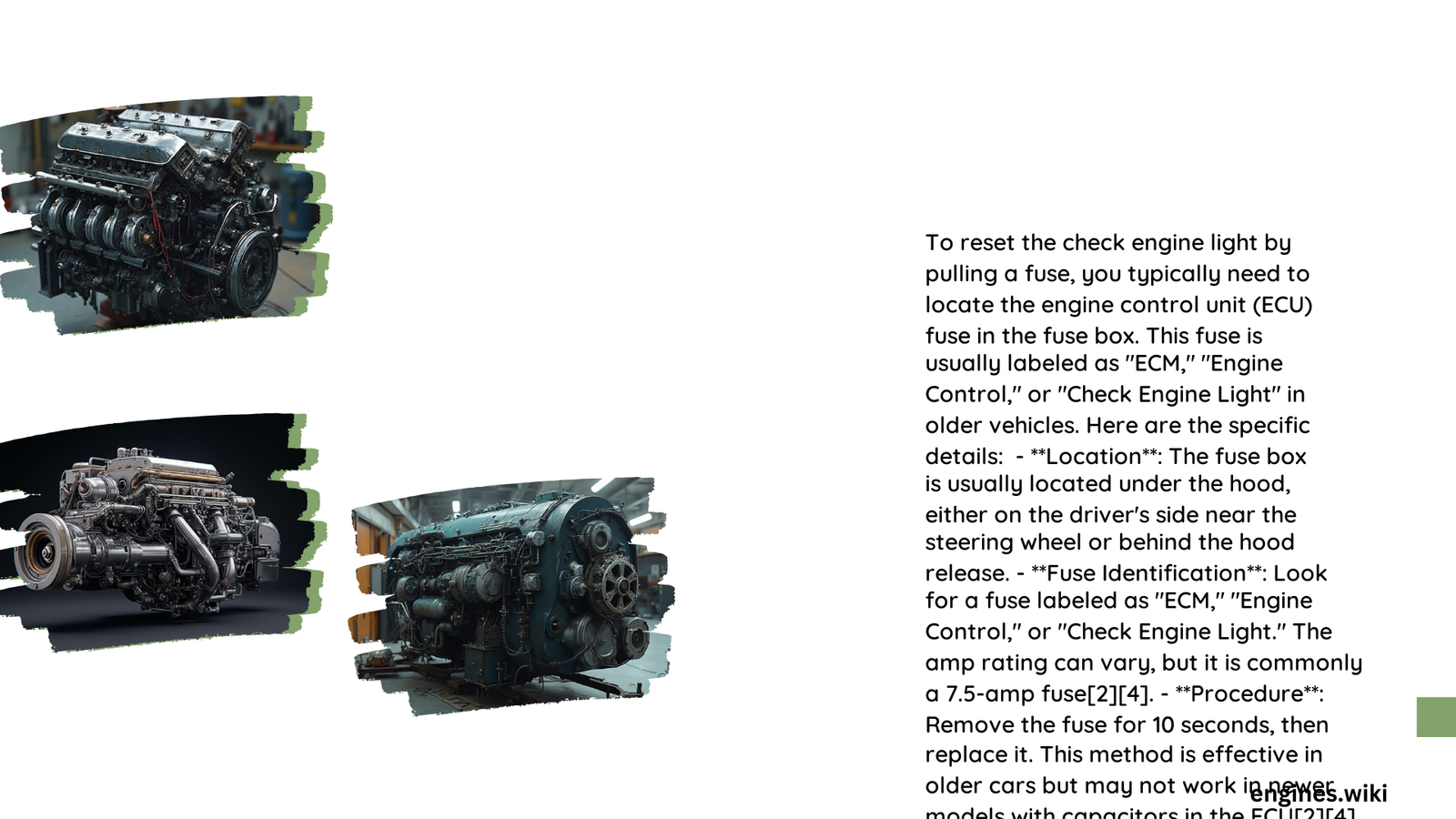To reset the check engine light by pulling a fuse, you need to identify the fuse associated with the Engine Control Module (ECM) or Powertrain Control Module (PCM). These modules are responsible for triggering the check engine light. The specific fuse to pull varies depending on your vehicle make and model. Generally, you’ll need to locate the fuse box, find the ECM/PCM fuse, remove it for a few minutes, then reinsert it to reset the system.
What Is the Purpose of Resetting the Check Engine Light?
Resetting the check engine light serves several purposes:
- Clearing temporary error codes
- Verifying if a repair has resolved the issue
- Preparing the vehicle for emissions testing
- Troubleshooting intermittent problems
However, it’s important to note that resetting the light without addressing the underlying issue may cause it to reappear shortly after.
How Do I Locate the Correct Fuse Box in My Vehicle?

Finding the right fuse box is crucial when attempting to reset the check engine light. Here’s how to locate it:
- Check the owner’s manual: This is your primary resource for locating the fuse box.
- Common locations:
- Under the dashboard on the driver’s side
- In the engine compartment, often near the battery
- In the trunk (less common, but found in some vehicles)
- Look for labeled covers: Fuse boxes are typically covered with a panel labeled “Fuse Box” or “Electrical Center.”
- Use online resources: If you can’t find your manual, search for your vehicle’s make, model, and year along with “fuse box location” online.
What Steps Should I Follow to Identify the ECM/PCM Fuse?
Identifying the correct fuse is critical. Follow these steps:
- Consult the fuse box diagram:
- Look for a diagram on the fuse box cover
- Check your owner’s manual for a detailed fuse layout
- Search for specific labels:
- Look for fuses labeled “ECM,” “PCM,” “Engine Control,” or “Powertrain Control”
- Use online resources:
- Search for your vehicle’s specific fuse diagram online
- Seek professional help:
- If unsure, consult a mechanic or dealership for guidance
What Tools Do I Need to Pull the Fuse Safely?
To safely remove the fuse, you’ll need the following tools:
| Tool | Purpose |
|---|---|
| Fuse puller | Specifically designed for safe fuse removal |
| Needle-nose pliers | Alternative to a fuse puller |
| Flashlight | For better visibility in dark areas |
| Gloves | To protect against electrical shock |
| Owner’s manual | For reference and guidance |
What Is the Correct Procedure for Pulling and Reinserting the Fuse?
Follow these steps to properly pull and reinsert the fuse:
- Ensure safety:
- Turn off the engine and remove the key
- Wear protective gloves
- Locate the fuse:
- Use the fuse box diagram to find the ECM/PCM fuse
- Remove the fuse:
- Gently pull the fuse straight out using a fuse puller or pliers
- Wait:
- Leave the fuse out for 10-15 minutes
- Reinsert the fuse:
- Carefully push the fuse back into its slot
- Check the system:
- Start the engine and verify if the check engine light has reset
What Precautions Should I Take When Resetting the Check Engine Light?
When resetting the check engine light, keep these precautions in mind:
- Don’t force the fuse: If it doesn’t come out easily, seek professional help
- Avoid touching other components: Stick to handling only the intended fuse
- Be aware of electrical risks: Always prioritize safety when working with electrical systems
- Don’t ignore persistent issues: If the light comes back on, address the underlying problem
- Consider diagnostic tools: For a more comprehensive approach, consider using an OBD-II scanner
What Are the Potential Risks of Pulling the Wrong Fuse?
Pulling the wrong fuse can lead to several issues:
- Disabling critical systems: Some fuses control essential vehicle functions
- Triggering additional error codes: Removing the wrong fuse may cause new diagnostic trouble codes
- Affecting vehicle performance: Certain systems may not function properly if the wrong fuse is removed
- Potential electrical damage: In rare cases, pulling the wrong fuse could lead to electrical system damage
How Can I Verify If the Check Engine Light Reset Was Successful?
To confirm if the reset was successful:
- Start the engine: Turn the key and start the vehicle
- Observe the dashboard: Watch for the check engine light during startup
- Drive the vehicle: Take a short drive to ensure the light doesn’t reappear
- Use an OBD-II scanner: For a more definitive check, use a scanner to verify no codes are present
- Monitor over time: Keep an eye on the light for several days to ensure it doesn’t come back on
What Should I Do If the Check Engine Light Comes Back On?
If the check engine light reappears after resetting:
- Don’t ignore it: The light indicates an ongoing issue that needs attention
- Use a diagnostic tool: An OBD-II scanner can help identify specific error codes
- Check for common issues: Look for loose gas caps, faulty sensors, or recent maintenance that might have triggered the light
- Consult a professional: If you can’t identify the issue, seek help from a qualified mechanic
- Address the root cause: Once identified, fix the underlying problem to prevent the light from returning
Remember, while resetting the check engine light by pulling a fuse can be a quick fix, it’s crucial to address any underlying issues to maintain your vehicle’s health and performance. Always prioritize safety and consult professionals when in doubt about automotive electrical systems.
References:
- AutoZone Guide on Fuse Identification and Replacement
- 2CarPros YouTube Video on Engine Fuse Replacement
- 2CarPros Fuse Box Diagram Guide
- [Vehicle Owner’s Manual (Specific to your make and model)]
